Exploring the Economic Hypothetical for Downhill Belt Conveyors Equipped with Three-Phase Active Front-End Load Converters
Abstract
1. Introduction
2. Scope of Work Reported
- -
- Brake A: A regenerative brake chopper for regular operation. This dynamic brake can absorb surplus energy and dissipate it to slow the conveyor, bringing it to a stop in about 30 s under normal stop conditions.
- -
- Brake B: A high-speed disk brake on the drive shaft, serving as an emergency brake. It can stop the conveyor within ~10 s in urgent conditions, handling scenarios where mechanical backup is needed.
- -
- Brake C: A low-speed drum or disk brake on the pulley shaft, providing a redundant emergency stop, also within ~10 s. This ensures fail-safe operation if both the regenerative and high-speed brakes are unavailable.
3. Methodology
3.1. Key Equations Governing the System’s Operation
- -
- is the artificial friction coefficient accounting for secondary resistances, such as idler misalignment, belt cleaner drag, etc.,
- -
- L is the conveyor length (m),
- -
- is the mass of idler rolls per unit length of the conveyor (kg/m),
- -
- is the mass of the belt per unit length (kg/m), multiplied by 2 to account for the top and bottom strands,
- -
- is the bulk material mass per unit length of the conveyor (kg/m), related to the carrying capacity and loading,
- -
- δ is the angle of inclination of the conveyor (degrees),
- -
- g is the gravitational acceleration (9.81 m/s2),
- -
- H is the vertical height difference between the head and tail pulleys (m), and
- -
- represents any special additional resistances, such as skirtboard friction and hopper drag.
3.2. Conveyor Belt System: Power Consumption Model
3.3. Active Front End Inverter Principles
- -
- A three-phase AC grid supply.
- -
- Input filter inductors to attenuate switching harmonics.
- -
- A rectifier utilizing insulated gate bipolar transistors (IGBTs).
- -
- A braking chopper connected to the DC link for energy dissipation.
- -
- A bidirectional control system interfacing with the grid and load conditions.
- -
- is the input power from the grid,
- -
- is the output power delivered to the load, and
- -
- stands for the losses in semiconductors, filters, and passive components.
- -
- is the voltage vector at the rectifier input,
- -
- is the grid voltage vector,
- -
- and are the filter inductances and resistances, respectively, and
- -
- represents the three-phase grid currents.
3.4. Active Front-End Inverter Control Strategy
- -
- Stabilizing voltage regulation enhances the overall performance and reliability of the power system.
- -
- Protects the system from overvoltage and undervoltage conditions, which can cause damage or inefficiencies.
- -
- Proper voltage regulation ensures efficient operation of the inverter and connected loads, reducing energy losses.
- -
- It minimizes voltage fluctuations, providing a consistent power supply to sensitive electronic devices.
3.5. Economic Viability
3.6. Financial Model Sensitivity Analysis
4. Results and Discussion
4.1. Conveyor Belt System Design Data Configuration
4.2. Financial Modeling and Assumption
- -
- Standard deviation: R350.28
- -
- Minimum price: R287,200.98
- -
- Maximum price: R288,410.64
- -
- Median price: R287,805.11
- -
- An energy recovery system is used to catch and convert surplus kinetic energy produced while the conveyor moves downhill.
- -
- The study considers many characteristics such as payback time, net present value, and return interest rate.
- -
- The evaluation of electricity tariff rates relies on distinguishing between low- and high-demand times.
4.3. Benefits Comparison: 3-Phase AFEL vs. DOL Induction Motor Technologies
5. Conclusions
Key Findings and Contributions of the Study
- -
- The AFE-equipped conveyor showed a ~37–39% reduction in net energy drawn from the grid, as it was able to feed power back during loaded downhill operation. Over the conveyor’s life, this translates to tens of GWh of energy saved, highlighting the significant impact on energy efficiency in mining operations.
- -
- Through dynamic modeling (MATLAB/Simulink) and control design, it was verified that the regenerative drive can maintain stable conveyor speed and acceptable belt tensions during various scenarios, such as the start-up, normal operation, sudden load changes. The system effectively works as a motor when needed and a generator, when possible, seamlessly switches roles. Soft-start capability of the AFE and the coordinated braking system (Brake A, B, C) ensure safe operation under all conditions.
- -
- The lifecycle cost analysis and financial modeling confirmed that despite a higher initial investment for the AFE system, the project yields a favorable economic return. As calculated, the payback period is ~6 years and the IRR is ~15%, which is very attractive. The NPV over 20 years was strongly positive, indicating that the investment not only pays for itself, but also generates additional value. These results were robust even under sensitivity scenarios of varying electricity inflation, meaning the regenerative system is a financially sound investment under a range of future conditions. This addresses a gap in the existing research by providing a long-term economic perspective, not just a short-term energy saving estimate.
- -
- The distinctiveness of this approach lies in the holistic integration of mechanical, electrical, and economic analyses. The study moved beyond a traditional DOL drive paradigm and demonstrated, via modeling and a case study, the advantages of regenerative AFE converters. The investigation utilized dynamic simulation tools to capture transient behaviors and design the control system, engineering design software (Sidewinder) to accurately parameterize the conveyor’s physical characteristics, and financial modeling to evaluate viability. This comprehensive methodology provides a template for evaluating similar systems in other industrial contexts.
- -
- Through reducing the energy drawn from coal-based power and feeding energy back, the AFE system contributes to lower carbon emissions. For energy-intensive sectors like mining, adopting such technologies can be a significant step toward sustainability and reducing the carbon footprint. The calculations show meaningful CO2 reductions, aligning the project with broader environmental and regulatory goals.
Author Contributions
Funding
Institutional Review Board Statement
Informed Consent Statement
Data Availability Statement
Acknowledgments
Conflicts of Interest
Acronyms and Nomenclature
| AC | Alternative current |
| AFE | Active front end |
| AFEL | Active front-end load |
| PBP | Payback period |
| CAPEX | Capital cost |
| CO₂ | Carbon dioxide |
| Carbon emission reduction | |
| CPP | Critical peak pricing |
| DBC | Downhill belt conveyor |
| DC | Direct current |
| DOL | Direct on-line |
| IGBT | Insulated gate bipolar transistors |
| IRR | Interest rate of return |
| LCC | Lifecycle cost |
| NPV | Net present value |
| OPEX | Operational cost |
| PI | Proportional–integral |
| PWM | Pulse width modulation |
| RTP | Real-time pricing |
| TOU | Time-of-use tariff |
| Belt acceleration | |
| B | Belt width |
| C | Secondary resistance factor |
| d | Discount rate |
| Total motional resistances | |
| Net forces | |
| Force that drives the system | |
| Unique resistances in the belt conveyors | |
| Artificial friction coefficient | |
| g | Gravity acceleration |
| H | Change in elevation between the head and tail pulleys |
| Input current vector | |
| Three-phase grid currents | |
| α-axis components of the grid currents | |
| β-axis components of the grid currents | |
| Phase currents | |
| Reference value for the α current | |
| Reference value for the β current | |
| Integral gain for the α component | |
| Integral gain for the β component | |
| Proportional gain for the β component | |
| Proportional gain for the α component | |
| Belt tension rating | |
| Initial lifecycle cost in year | |
| Lifecycle cost in year | |
| L | Conveyor length |
| Filter inductance | |
| Idler’s mass | |
| Conveyor belt mass | |
| Equivalent mass of the belt | |
| Equivalent mass of the load | |
| Bulk material mass per length unit | |
| Variable-speed bulk material mass per meter | |
| MC | Maintenance cost |
| m | Maintenance ratio |
| Min | Minimum value function |
| Max | Maximum value function |
| n | Total number of data points |
| Number of conveyor belt systems | |
| Useful lifetime of the asset in years | |
| Final year with a negative cumulative cash flow | |
| Operational expenditure in year | |
| Active frontend power | |
| Direct online power | |
| Electrical power required | |
| Electrical power consumption at the nominal speed | |
| Electrical power consumption at a variable speed | |
| Input power from the grid | |
| Electricity tariff in year | |
| Electricity prices | |
| Mechanical power | |
| Output power delivered to the load | |
| Power losses in semiconductors, filters, and passive components | |
| Power savings in an AFE-integrated system | |
| Power saving ratio | |
| Filter resistance | |
| , | Switching states |
| Switching state vector of the rectifier | |
| Minimum safety factor in transient operations | |
| SV | Salvage value |
| Maximum belt tension before the drive pulley | |
| T2 | Tension of the belt after the drive pulley |
| Electricity consumption rates | |
| Voltage vector at the rectifier input | |
| Grid voltage vector | |
| Phase voltages | |
| Frame voltages | |
| Supply voltage vector | |
| Switching state of the converter and the DC link voltage | |
| Variable conveyor belt velocity | |
| DC link voltage | |
| Rectifier voltage | |
| Reference DC link voltage | |
| Nominal conveyor belt velocity | |
| Individual data point in the dataset | |
| Individual data point | |
| Individual data points in the pricing dataset | |
| μ | Mean dataset |
| Efficiency of the inverter | |
| System efficiency | |
| Driving system efficiency at the nominal speed | |
| Driving system efficiency at a variable speed | |
| Mean angle of inclination of the installation | |
| θ | Wrap angle on the drive pulley |
| α and β | Axis components of the grid |
References
- Rocha, A.V.; Franca, G.J.; dos Santos, M.E.; de Paula, H.; Filho, B.J.C. Increasing Long-Belt-Conveyor Availability by Using Fault-Resilient Medium-Voltage AC Drives. IEEE Trans. Ind. Appl. 2012, 48, 1708–1716. [Google Scholar] [CrossRef]
- Mathaba, T.; Xia, X. A Parametric Energy Model for Energy Management of Long Belt Conveyors. Energies 2015, 8, 13590–13608. [Google Scholar] [CrossRef]
- Zhang, S.; Xia, X. Optimal control of operation efficiency of belt conveyor systems. Appl. Energy 2010, 87, 1929–1937. [Google Scholar] [CrossRef]
- Grincova, A.; Andrejiova, M.; Marasova, D.; Khouri, S. Measurement and determination of the absorbed impact energy for conveyor belts of various structures under impact loading. Measurement 2019, 131, 362–371. [Google Scholar] [CrossRef]
- Rodríguez, J.; Pontt, J.; Becker, N.; Weinstein, A. Regenerative Drives in the Megawatt Range for High-Performance Downhill Belt Conveyors. IEEE Trans. Ind. Appl. 2002, 38, 203–210. [Google Scholar] [CrossRef]
- Parreiras, T.M.; Justino, J.C.G.; Rocha, A.V.; Filho, B.J.C. True Unit Power Factor Active Front End for High-Capacity Belt-Conveyor Systems. IEEE Trans. Ind. Appl. 2016, 52, 2737–2746. [Google Scholar] [CrossRef]
- Kawalec, W.; Król, R.; Suchorab, N. Regenerative Belt Conveyor versus Haul Truck-Based Transport: Polish Open-Pit Mines Facing Sus-tainable Development Challenges. Sustainability 2020, 12, 9215. [Google Scholar] [CrossRef]
- Rodriguez, J.; Pontt, J.; Alzarnora, G.; Becker, N.; Einenkel, O.; Weinstein, A. Novel 20-MW downhill conveyor system using three-level converters. IEEE Trans. Ind. Electron. 2002, 49, 1093–1100. [Google Scholar] [CrossRef]
- Zhang, S.; Xia, X. Modeling and energy efficiency optimization of belt conveyors. Appl. Energy 2011, 88, 3061–3071. [Google Scholar] [CrossRef]
- Bebic, M.Z.; Ristic, L.B. Speed controlled belt conveyors: Drives and mechanical considerations. Adv. Electr. Comput. Eng. 2018, 18, 51–60. [Google Scholar] [CrossRef]
- He, D.; Liu, X.; Zhong, B. Sustainable belt conveyor operation by active speed control. Meas. J. Int. Meas. Confed. 2020, 154, 107458. [Google Scholar] [CrossRef]
- Mathaba, T.; Xia, X. Optimal and energy efficient operation of conveyor belt systems with downhill conveyors. Energy Effic. 2017, 10, 405–417. [Google Scholar] [CrossRef]
- Luchinger, P.; Maier, U.; Errath, R.A. Active front end technology in the application of a downhill conveyor. In Proceedings of the IEEE Cement Industry Technical Conference, 2006 Conference Record, Phoenix, AZ, USA, 9–14 April 2006; IEEE: New York, NY, USA, 2006; pp. 175–194. [Google Scholar] [CrossRef]
- Fangwei, X.; Youfu, H.; Fei, H. Control strategy of disc braking systems for downward belt conveyors. Min. Sci. Technol. 2011, 21, 491–494. [Google Scholar] [CrossRef]
- He, D.; Pang, Y.; Lodewijks, G. Green operations of belt conveyors by means of speed control. Appl. Energy 2017, 188, 330–341. [Google Scholar] [CrossRef]
- Chen, H.; Zeng, F.; Du, J.; Zhou, S. An improved optimal model for energy-saving of belt conveyors based on genetic algorithm. In Proceedings of the 2015 IEEE International Conference on Information and Automation, Lijiang, China, 8–10 August 2015; IEEE: New York, NY, USA, 2015; pp. 2784–2788. [Google Scholar] [CrossRef]
- Hiltermann, J.; Lodewijks, G.; Schott, D.L.; Rijsenbrij, J.C.; Dekkers, J.A.J.M.; Pang, Y. A methodology to predict power savings of troughed belt conveyors by speed control. Part. Sci. Technol. 2011, 29, 14–27. [Google Scholar] [CrossRef]
- Chelopo, D. An Investigation into The Most Efficient Brake Disc Material for Application on Overland and Decline Belt Conveyor Systems. Master’s Thesis, University of Johannesburg, Johannesburg, South Africa, 2020. Volume 0002. Available online: https://ujcontent.uj.ac.za/esploro/outputs/graduate/An-investigation-into-the-most-efficient/9911545807691 (accessed on 22 August 2017).
- Ji, J.; Miao, C.; Li, X.; Liu, Y. Research on the energy-saving control strategy of a belt conveyor with variable belt speed based on the material flow rate. PLoS ONE 2021, 16, e0247279. [Google Scholar] [CrossRef]
- He, D.; Pang, Y.; Lodewijks, G. Speed control of belt conveyors during transient operation. Powder Technol. 2016, 301, 622–631. [Google Scholar] [CrossRef]
- He, D.; Pang, Y.; Lodewijks, G. Belt Conveyor Dynamics in Transient Operation for Speed Control. Int. J. Eng. Technol. 2016, 8, 844–849. [Google Scholar] [CrossRef]
- Luo, W.; Zhao, T.; Li, X.; Wang, Z.; Wu, L. Adaptive super-twisting sliding mode control of three-phase power rectifiers in active front end applications. IET Control Theory Appl. 2019, 13, 1483–1490. [Google Scholar] [CrossRef]
- Rodriguez, P.; Lai, N.B. Grid-following and grid-forming PV and wind turbines. In Control of Power Electronic Converters and Systems; Elsevier: Amsterdam, The Netherlands, 2021; pp. 499–521. [Google Scholar] [CrossRef]
- Chimonyo, K.B.; Kumar, S.K.; Kumar, K.B.; Ravi, K. Design and Analysis of Electrical Drives Using Active Front End Converter. In Proceedings of the 2018 Second International Conference on Inventive Communication and Computational Technologies (ICICCT), Coimbatore, India, 20–21 April 2018; IEEE: New York, NY, USA, 2018; pp. 115–119. [Google Scholar] [CrossRef]
- Kumar, A.; Srungavarapu, G. Algorithm-based direct power control of active front-end rectifiers. IET Power Electron. 2019, 12, 712–718. [Google Scholar] [CrossRef]
- Andang, A.; Sativa, O.; Chobir, A. Active Front End Converter with Simple Control for Improved Power Quality. In Proceedings of the 2022 International Conference on Informatics Electrical and Electronics (ICIEE), Yogyakarta, Indonesia, 5–7 October 2022; IEEE: New York, NY, USA, 2022; pp. 1–6. [Google Scholar] [CrossRef]
- Douglass, P.J.; Trintis, I. Balancing distribution systems with three-phase active front end rectifiers: Field experiment results. IET Gener. Transm. Distrib. 2017, 11, 3749–3755. [Google Scholar] [CrossRef]
- Bankovi, B.; Mitrovi, N.; Kosti, V.; Petronijevi, M. Application of Active Front End Rectifier in Electrical Drives. In Proceedings of the ICEST 2012, Veliko Tarnovo, Bulgaria, 28–30 June 2012; pp. 556–559. [Google Scholar]
- Fang, H.; Zhang, Z.; Feng, X.; Kennel, R. Ripple-reduced model predictive direct power control for active front-end power converters with extended switching vectors and time-optimised control. IET Power Electron. 2016, 9, 1914–1923. [Google Scholar] [CrossRef]
- Masoum, M.A.S.; Fuchs, E.F. The Roles of Filters in Power Systems and Unified Power Quality Conditioners. In Power Quality in Power Systems and Electrical Machines; Elsevier: Amsterdam, The Netherlands, 2015; pp. 779–886. [Google Scholar] [CrossRef]
- CortÉs, P.; RodrÍguez, J.; Antoniewicz, P.; Kazmierkowski, M. Direct Power Control of an AFE Using Predictive Control. IEEE Trans. Power Electron. 2008, 23, 2516–2523. [Google Scholar] [CrossRef]
- Larrinaga, P.; Campos-Celador, Á.; Legarreta, J.; Diarce, G. Evaluation of the theoretical, technical and economic potential of industrial waste heat recovery in the Basque Country. J. Clean. Prod. 2021, 312, 127494. [Google Scholar] [CrossRef]
- LeckNer, M.; Zmeureanu, R. Life cycle cost and energy analysis of a Net Zero Energy House with solar combisystem. Appl. Energy 2011, 88, 232–241. [Google Scholar] [CrossRef]
- Ong, H.C.; Mahlia, T.M.I.; Masjuki, H.H.; Honnery, D. Life cycle cost and sensitivity analysis of palm biodiesel production. Fuel 2012, 98, 131–139. [Google Scholar] [CrossRef]
- Mathaba, T.N.D. Energy and Cost Optimal Scheduling of Belt Conveyor Systems; University of Pretoria: Pretoria, South Africa, 2016; Available online: https://link.springer.com/article/10.1007/s12053-016-9461-8 (accessed on 11 December 2024).
- Saidur, R.; Mekhilef, S.; Ali, M.B.; Safari, A.; Mohammed, H.A. Applications of variable speed drive (VSD) in electrical motors energy savings. Renew. Sustain. Energy Rev. 2012, 16, 543–550. [Google Scholar] [CrossRef]
- Chaeikar, S.S.; Manaf, A.A.; Alarood, A.A.; Zamani, M. PFW: Polygonal Fuzzy Weighted—An SVM Kernel for the Classification of Over-lapping Data Groups. Electronics 2020, 9, 615. [Google Scholar] [CrossRef]
- Shaw, W.G.; Mathews, M.; Marais, J. Holistic analysis of the effect on electricity cost in South Africa’s platinum mines when varying shift schedules according to time-of-use tariffs. J. Energy S. Afr. 2019, 30, 26–40. [Google Scholar] [CrossRef]
- Ndou, E.; Gumata, N. Should the South African Reserve Bank lower the inflation target band? Insights from the GDP-inflation nexus. J. Policy Model 2024, 46, 638–654. [Google Scholar] [CrossRef]
- Musango, J.; Bassi, A.; Brent, A. South African Energy Model: A System Dynamics Approach. In Proceedings of the 27th International Conference of System Dynamics Society, Albuquerque, NM, US, 26–31 July 2009; pp. 1–32. Available online: https://proceedings.systemdynamics.org/2009/proceed/papers/P1106.pdf (accessed on 16 March 2024).
- Eskom. EskomcTariffs & Charges Booklet 2021/2022. Vol. 2022. Available online: https://www.eskom.co.za/distribution/wp-content/uploads/2022/04/Tariff-Booklet-final.pdf (accessed on 16 March 2024).
- Mathaba, T.; Xia, X.; Zhang, J. Optimal scheduling of conveyor belt systems under Critical Peak Pricing. In Proceedings of the 2012 10th International Power & Energy Conference (IPEC), Ho Chi Minh City, Vietnam, 12–14 December 2012; IEEE: New York, NY, USA, 2012; pp. 315–320. [Google Scholar] [CrossRef]
- Dube, S.; Zhou, Y. South Africa’s Short- and Long-Term Interest Rates: A Threshold Cointegration Analysis. Bus. Econ. Res. 2013, 3, 187–211. [Google Scholar] [CrossRef]
- Kumar, V.; Saxena, V.K.; Kumar, R.; Kumar, S. Energy, exergy, sustainability and environmental emission analysis of coal-fired thermal power plant. Ain Shams Eng. J. 2024, 15, 102416. [Google Scholar] [CrossRef]
- He, D. Energy Saving for Belt Conveyors by Speed Control. Ph.D. Thesis, Delft University of Technology Energy, Delft, The Netherlands, 2017. [Google Scholar] [CrossRef]
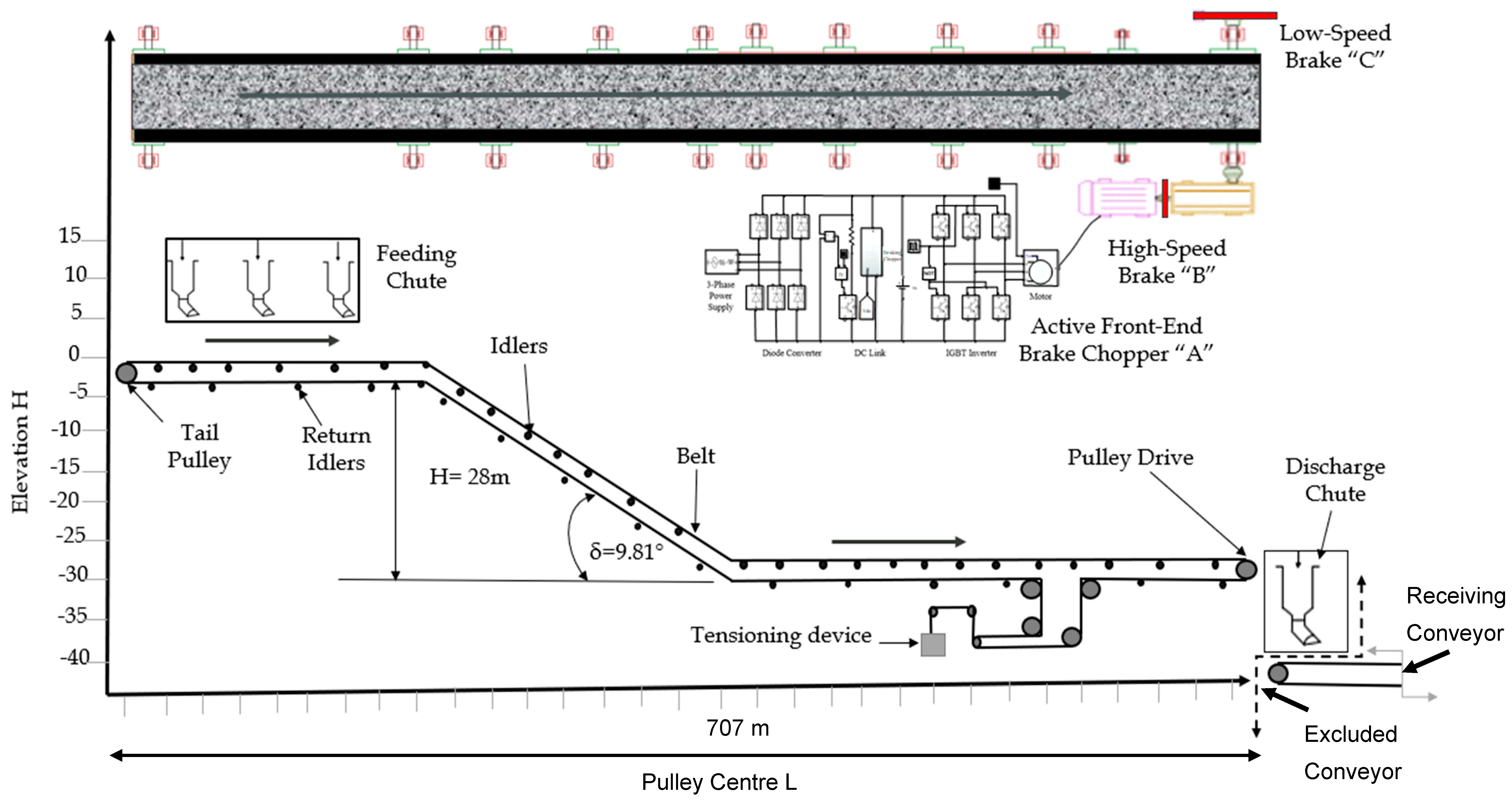
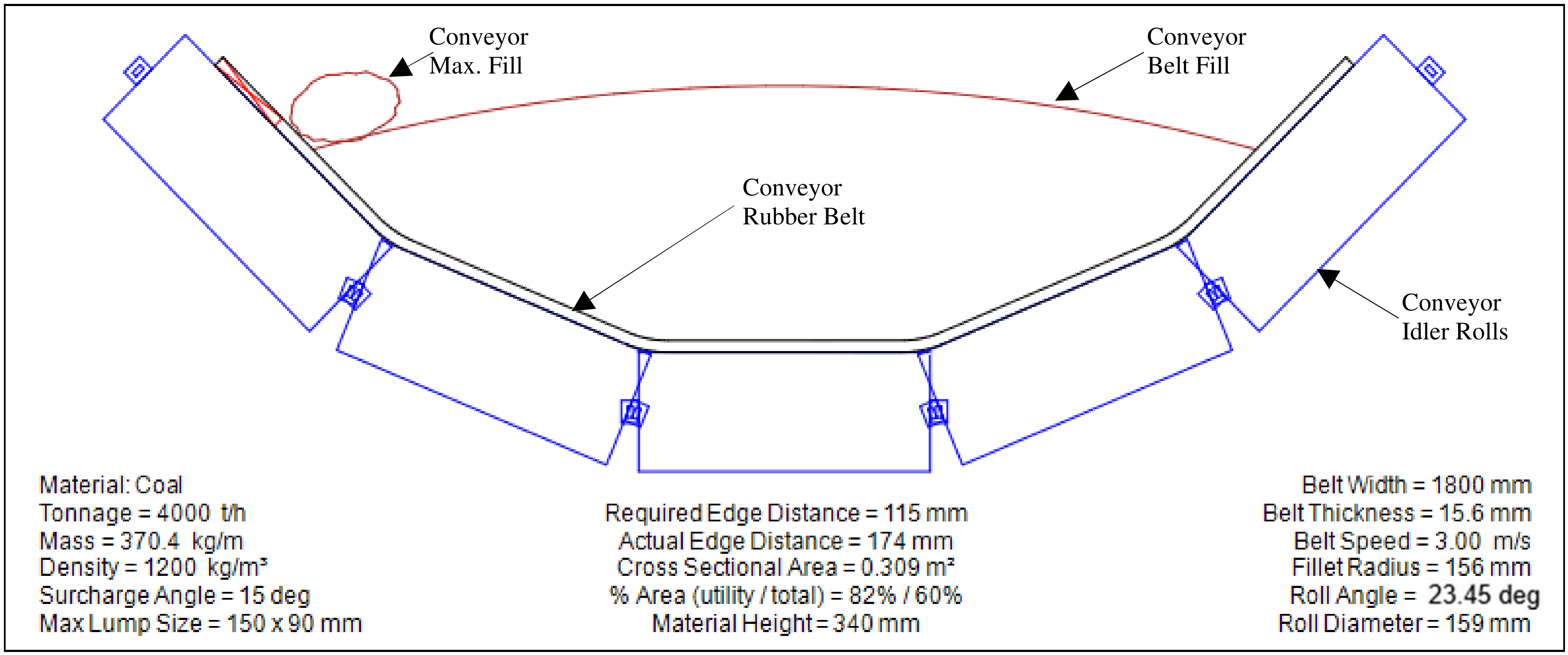
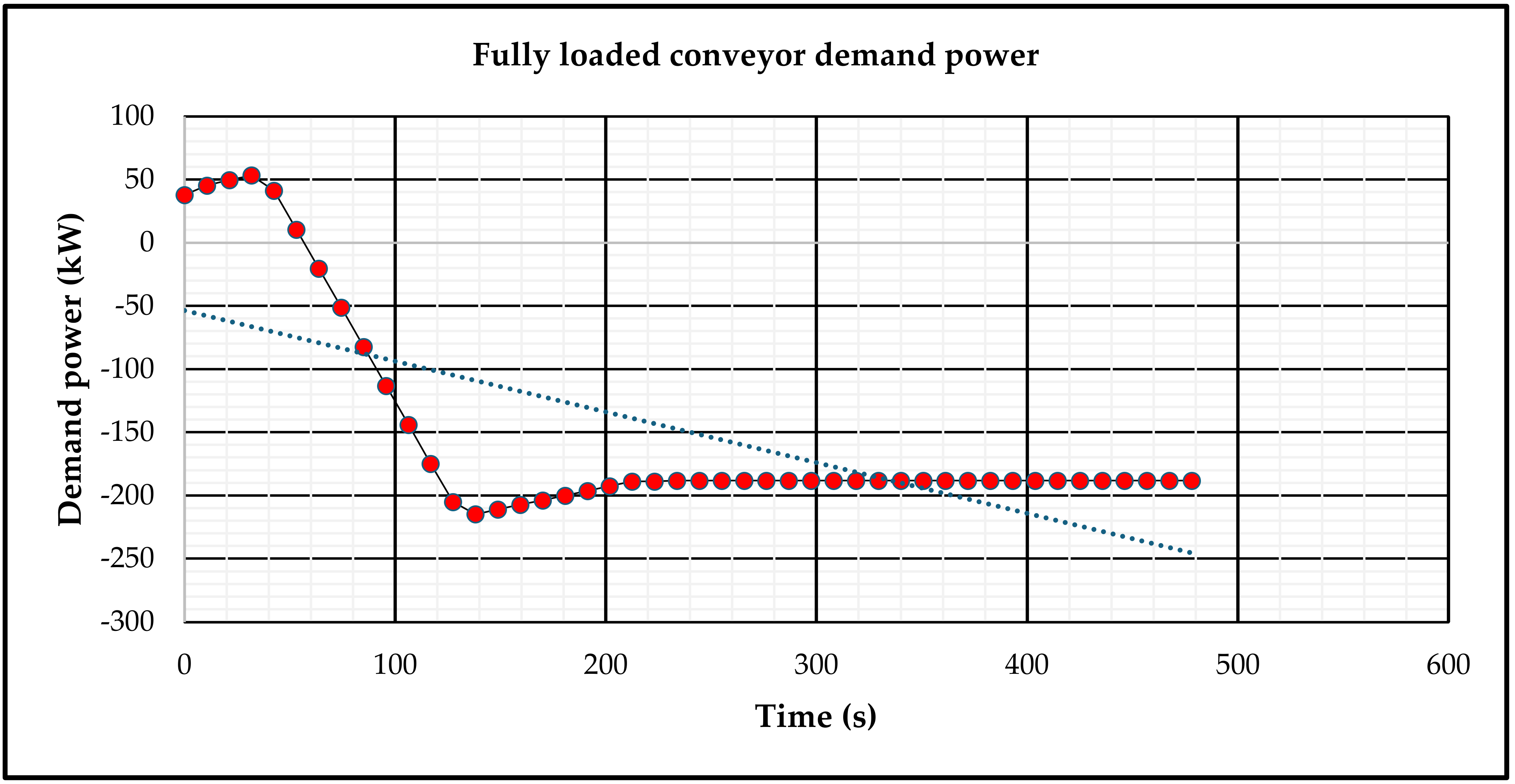

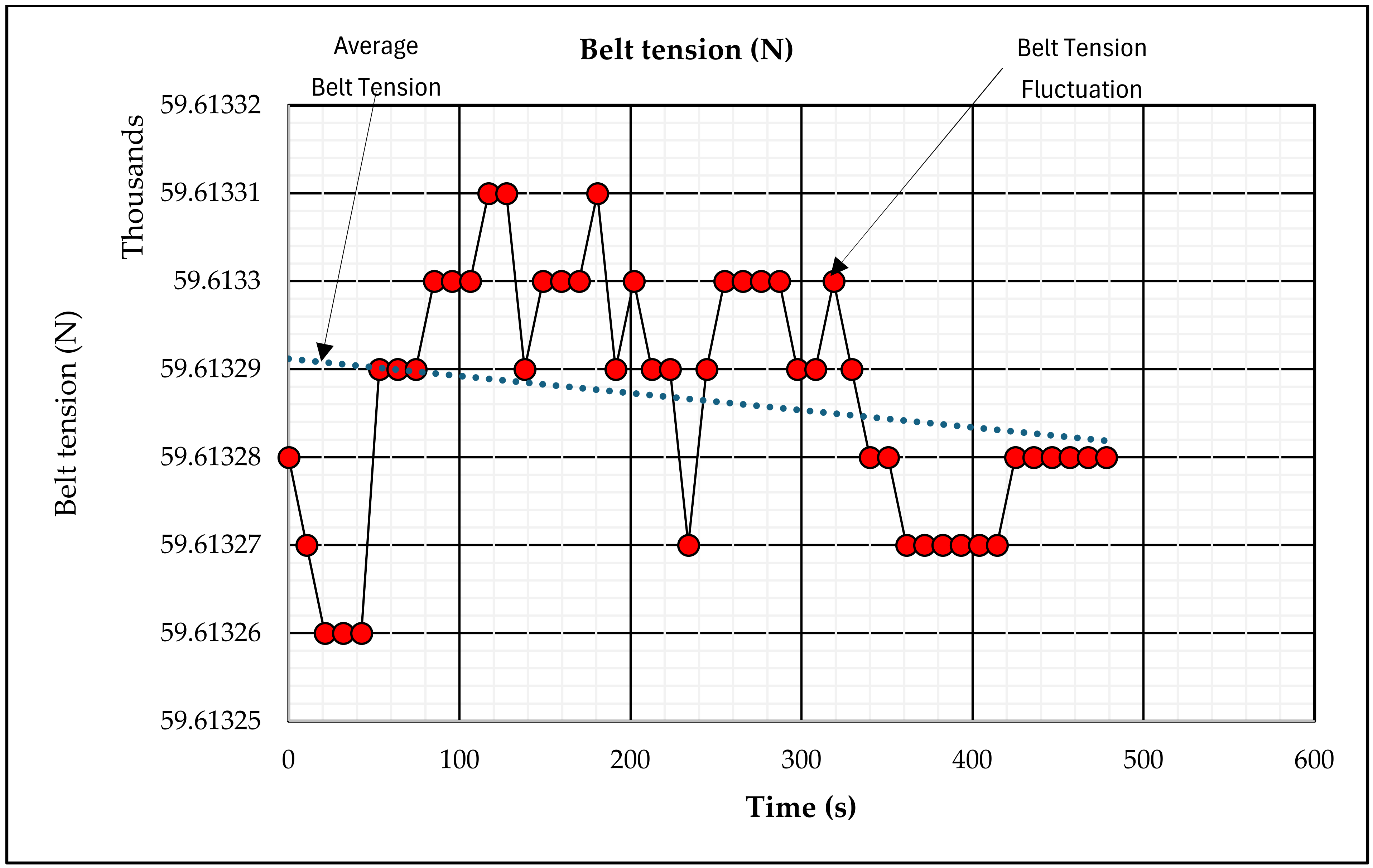

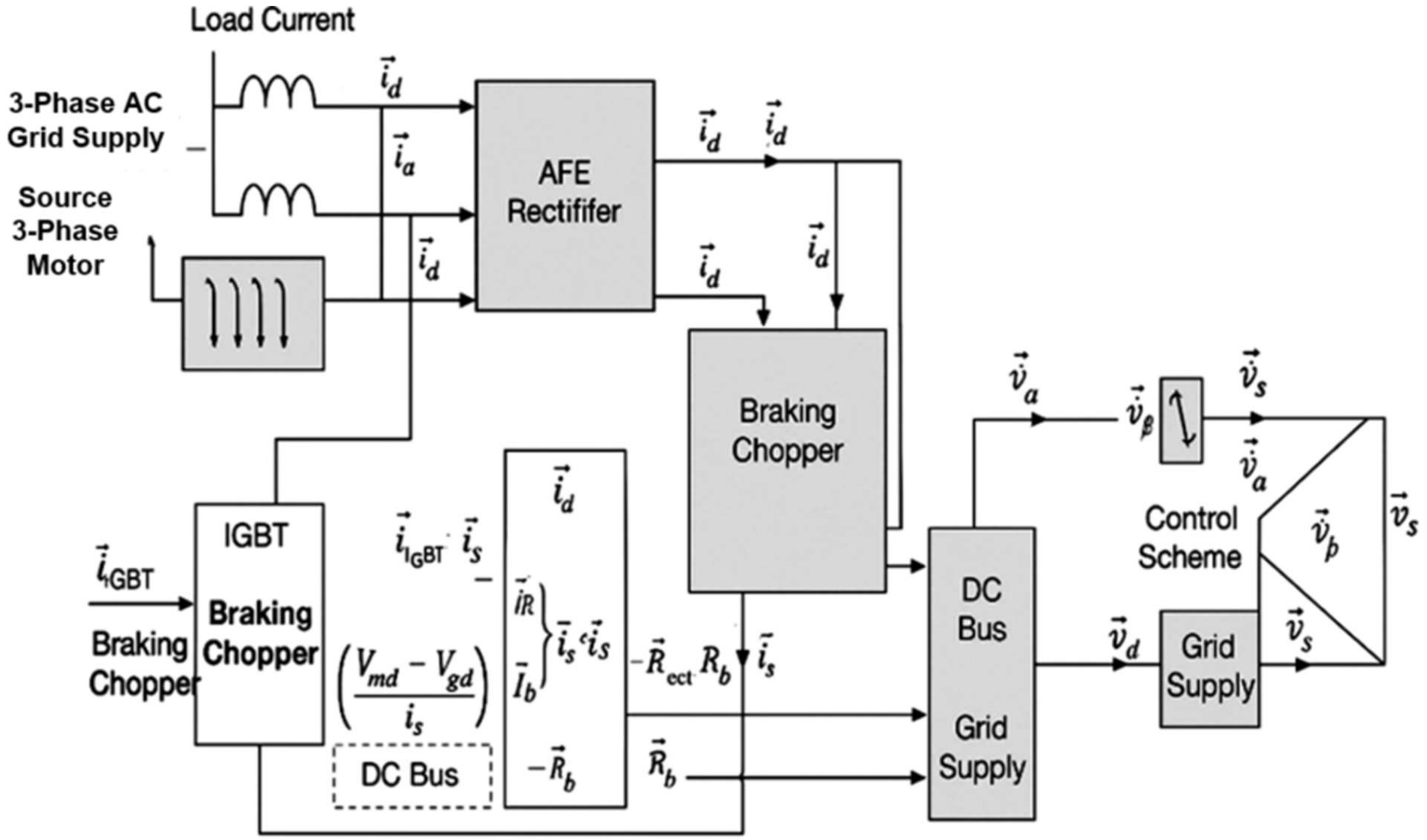
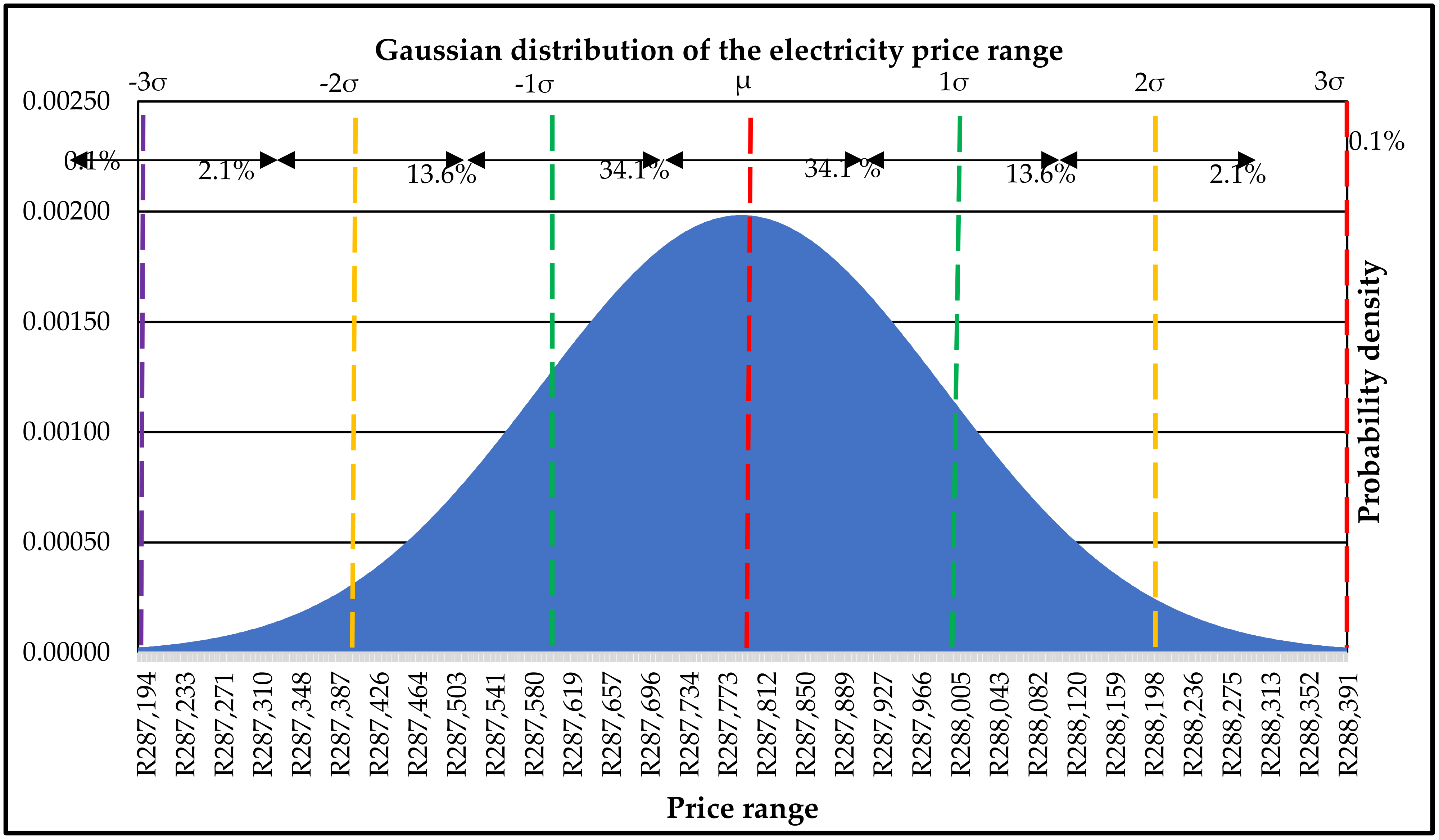
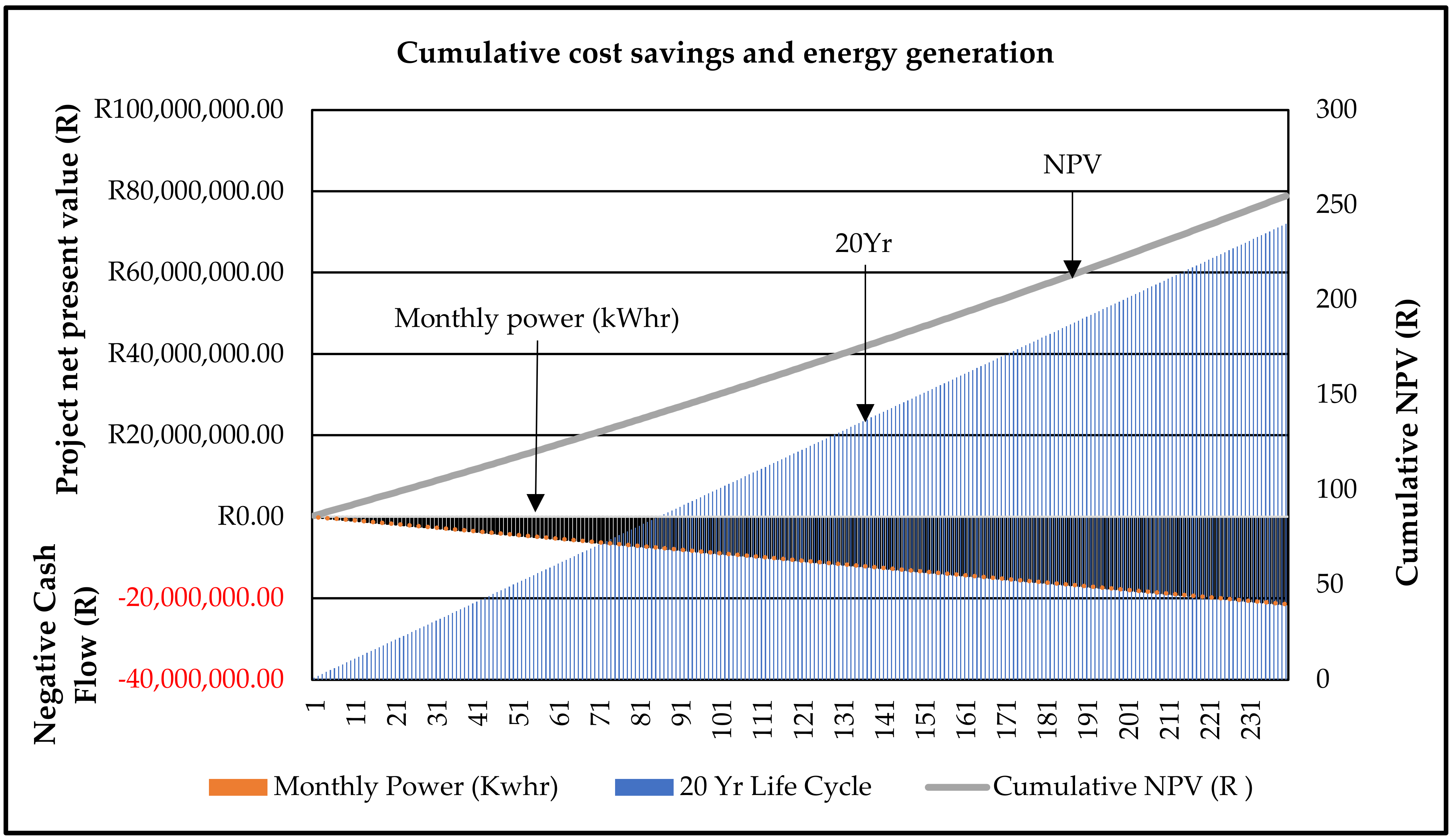
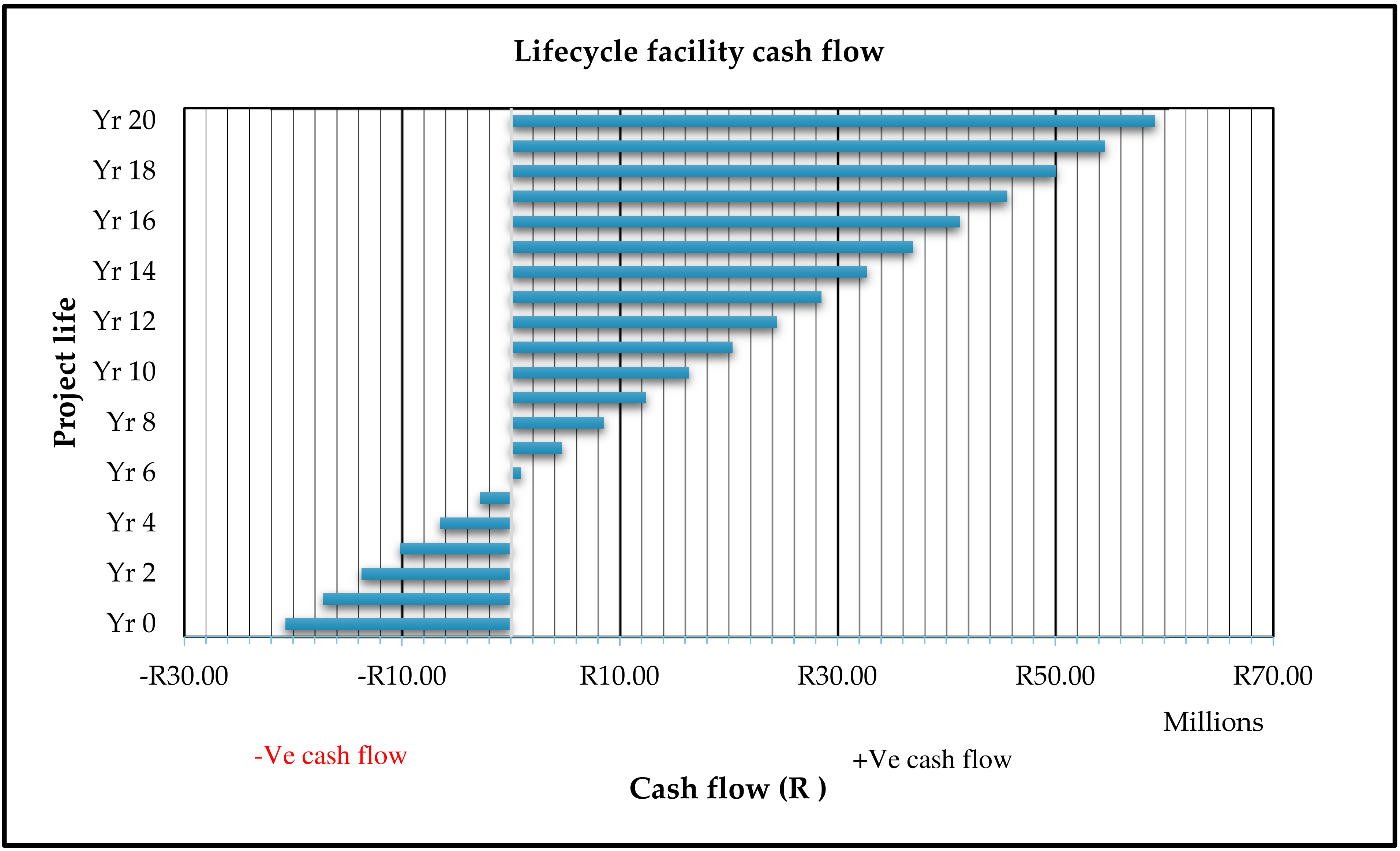


| Low-Demand Season (1 September to 31 May) | High-Demand Season (1 June to 31 August) | ||||||
|---|---|---|---|---|---|---|---|
| Season | c/kWh | Hours/day | Daily Total | Season | c/kWh | Hours/day | Daily Total |
| Off-peak | 59.07 | 8 | −R888 | Off-peak | 68.25 | 8 | −R1026 |
| Standard | 93.15 | 1 | −R175 | Standard | 125.68 | 1 | −R236 |
| On-peak | 135.37 | 3 | −R763 | On-peak | 414.91 | 3 | −R2340 |
| Standard | 93.15 | 8 | −R1401 | Standard | 125.68 | 8 | −R1890 |
| On-peak | 135.37 | 2 | −R509 | On-peak | 414.91 | 2 | −R1560 |
| Standard | 93.15 | 2 | −R350 | Standard | 125.68 | 2 | −R473 |
| Daily average | −101.54 | 24 | −R4087 | Daily average | −212.52 | 24 | R7526 |
| Description | Data | Unit |
|---|---|---|
| Total power | −188 | kWh |
| Operating hours | 17 | Hours/day |
| Monthly generation | −89,488 | kWh |
| Low-demand cost | R90,869.10 | kWh/month |
| High-demand cost | R190,178.41 | kWh/month |
| Total demand cost | R281,047.50 | kWh/month |
| Lifecycle generation | −R21,477,120.00 | kWh |
| Forecast tariff increase | 3% to 6% | Inflation rate target |
| Minimum cost | R287,173.43 | kWh/month |
| Mean cost | R287,779.52 | kWh/month |
| Maximum cost | R288,385.62 | kWh/month |
| Standard deviation | 350.97 | kWh/month |
| Description | AFE data | DOL data | Unit |
|---|---|---|---|
| Total power | −188 | 300 | kWh |
| Operating hours | 17 | 17 | Hours/day |
| Monthly generation | −89,488 | 142,800 | kWh |
| Low-demand cost | R90,869.10 | −145,003.88 | kWh/month |
| High-demand cost | R190,178.41 | −R303,476.18 | kWh/month |
| Total demand cost | R281,047.50 | −R448,480.06 | kWh/month |
| Lifecycle generation | −R21,477,120.00 | 0 | kWh |
| Forecast tariff increase | 3% to 6% | 11% to 14% | Inflation rate target |
| Minimum cost | R287,173.43 | −R443,593.71 | kWh/month |
| Mean cost | R287,779.52 | −R442,629.52 | kWh/month |
| Maximum cost | R288,385.62 | −R441,665.34 | kWh/month |
| Standard deviation | 350.97 | 558.34 | kWh/month |
Disclaimer/Publisher’s Note: The statements, opinions and data contained in all publications are solely those of the individual author(s) and contributor(s) and not of MDPI and/or the editor(s). MDPI and/or the editor(s) disclaim responsibility for any injury to people or property resulting from any ideas, methods, instructions or products referred to in the content. |
© 2025 by the authors. Licensee MDPI, Basel, Switzerland. This article is an open access article distributed under the terms and conditions of the Creative Commons Attribution (CC BY) license (https://creativecommons.org/licenses/by/4.0/).
Share and Cite
Chelopo, D.; Gupta, K. Exploring the Economic Hypothetical for Downhill Belt Conveyors Equipped with Three-Phase Active Front-End Load Converters. Technologies 2025, 13, 185. https://doi.org/10.3390/technologies13050185
Chelopo D, Gupta K. Exploring the Economic Hypothetical for Downhill Belt Conveyors Equipped with Three-Phase Active Front-End Load Converters. Technologies. 2025; 13(5):185. https://doi.org/10.3390/technologies13050185
Chicago/Turabian StyleChelopo, Daniel, and Kapil Gupta. 2025. "Exploring the Economic Hypothetical for Downhill Belt Conveyors Equipped with Three-Phase Active Front-End Load Converters" Technologies 13, no. 5: 185. https://doi.org/10.3390/technologies13050185
APA StyleChelopo, D., & Gupta, K. (2025). Exploring the Economic Hypothetical for Downhill Belt Conveyors Equipped with Three-Phase Active Front-End Load Converters. Technologies, 13(5), 185. https://doi.org/10.3390/technologies13050185





